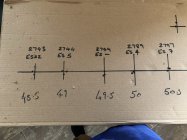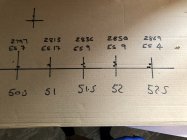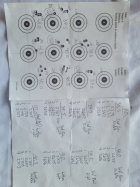Absolutely!Can this test be done with the magnetospeed installed on the barrel?
You are using an out of date browser. It may not display this or other websites correctly.
You should upgrade or use an alternative browser.
You should upgrade or use an alternative browser.
Long range load development at 100 yards.
- Thread starter Erik Cortina
- Start date
@Killick, good work following the program. Now that you have your seating depth and rough powder, test for positive compensation at 1,000 yards. This test is best early inthe morning, or whenever your range conditions are the calmest. Using your determined seating depth, Load 5 sighters at 51.8 and then 3 rounds at 51.6, 51.7, 51.8, 51.9, and 52.0.Final²...Well, no contest. .015" is the winner. 17 of 20 are X ring waterline. The 9 was was a missed fishtail.
"3, in the corner pocket!"
Use the sighters to center you target, then shoot each of the 3 round groups in succession keeping same POA. Be sure to shoot each 3 round group consecutively, quick, and in the same wind condition (not round robin). Meaning don’t start a new 3 round group until conditions seem consistent, then rip off 3 shots.
After firing each group, measure the vertical spread of each powder increment. Ignore the horizontal, one or two of them will show a very tight vertical. When I do this final test, I will find that my powder increment changes slightly from where I started and my best verticals are 2” or less.
Can this test be done with the magnetospeed installed on the barrel?
I've read that the magnetoapeed influences POI, but will it impact group shape? That's why I ask.Absolutely!
If the shape is the same, then I can do full testing with the magnetospeed which would be nice.
Thanks Killick, just want to make sure here
Ned Ludd
Silver $$ Contributor
Having the MagnetoSpeed attached can affect both POI and group size/shape. It doesn't necessarily have to, but it can, and often does. This has been addressed extensively here over the years. For a variety of reasons, I would suggest loading a few extra rounds, using some to measure velocity, and then leaving the MS off (unattached) when you shoot your groups. Maybe you can get away with having the MS attached, but given the time and effort that goes into the reloading process, as well as the current cost and lack of availability of reloading components, why risk it?I've read that the magnetoapeed influences POI, but will it impact group shape? That's why I ask.
If the shape is the same, then I can do full testing with the magnetospeed which would be nice.
Thanks Killick, just want to make sure here
This is with a 6.5 creedmoor, 7.5 twist using 140 grain JLK VLDs.
This target was shot with Virgin Lapua brass. Might have an impact. Shot with the magnetospeed attached.
On the target:
•Big number is the powder charge
•top number is group size
•numbers next to bullet holes are distance from the center line of the target
To me it looks like the node is between 40.5 and 41.5. Not sure what happened with the flier to the right on 41.5. Also 39.0 might also be a good one..
Thoughts?
This target was shot with Virgin Lapua brass. Might have an impact. Shot with the magnetospeed attached.
On the target:
•Big number is the powder charge
•top number is group size
•numbers next to bullet holes are distance from the center line of the target
To me it looks like the node is between 40.5 and 41.5. Not sure what happened with the flier to the right on 41.5. Also 39.0 might also be a good one..
Thoughts?
Attachments
Last edited:
Hi everyone, first post on the forum. Hope its ok to resurrect this thread.
I’ve just done my test per Erik’s instructions.
6.5x284. Shooting 147ELD-M. VV N165.
The 49.5gr load only had one velocity result,(labradar moved on the bench) hence no ES.
Any chance I could have some advice on where you think I should be starting? I’m thinking 51.5 based on the verticals but there’s quite a jump in velocity from 51-51.5.
Thanks for any help.
Jon.


I’ve just done my test per Erik’s instructions.
6.5x284. Shooting 147ELD-M. VV N165.
The 49.5gr load only had one velocity result,(labradar moved on the bench) hence no ES.
Any chance I could have some advice on where you think I should be starting? I’m thinking 51.5 based on the verticals but there’s quite a jump in velocity from 51-51.5.
Thanks for any help.
Jon.


51.7gr do seating in .3 increments 3 shot groupsHi everyone, first post on the forum. Hope its ok to resurrect this thread.
I’ve just done my test per Erik’s instructions.
6.5x284. Shooting 147ELD-M. VV N165.
The 49.5gr load only had one velocity result,(labradar moved on the bench) hence no ES.
Any chance I could have some advice on where you think I should be starting? I’m thinking 51.5 based on the verticals but there’s quite a jump in velocity from 51-51.5.
Thanks for any help.
Jon.
View attachment 1266198View attachment 1266200
Thanks for the input, 51.7 does seem the obvious choice now!
Seating depth wise, I’m jam -20thou which worked out at 2.600bto for the charge testing would you work from there? So, 2.597, 2.594, 2.591 etc..
thanks again for your help.
Seating depth wise, I’m jam -20thou which worked out at 2.600bto for the charge testing would you work from there? So, 2.597, 2.594, 2.591 etc..
thanks again for your help.
Ok,
I’ll test 50.7, 51 and 51.3. See how those pan out before starting on seating depth tests.
Thanks.
I’ll test 50.7, 51 and 51.3. See how those pan out before starting on seating depth tests.
Thanks.
Why not do seating test at 50.7, then go back to powder test?Ok,
I’ll test 50.7, 51 and 51.3. See how those pan out before starting on seating depth tests.
Thanks.
Hi,Why not do seating test at 50.7, then go back to powder test?
Thanks for the input.
Can you tell me why you would suggest that? I’m completely new to this type of load development and value everyone’s help. My understanding so far says to get the charge weight right then go to seating depths.
Is it wise to start seating depth tests on a unknown charge weight?
Thanks again.
Just a different way to get to finish line. Lots of us start out a grain and half or so below a known max book load to do a seating test. Then take the best group and play with .3 or .2 powder charges. This is just the first method that I picked up on this forum , just like you picked up the other way.Hi,
Thanks for the input.
Can you tell me why you would suggest that? I’m completely new to this type of load development and value everyone’s help. My understanding so far says to get the charge weight right then go to seating depths.
Is it wise to start seating depth tests on a unknown charge weight?
Thanks again.
I am new to reloading and reading from the beginning cant figure out what does it mean? What is the longest side of the node?9. When you find the seating depth test that shoots the best, load towards the longest side of the node to allow more room for throat erosion.
This means if for example your best seating depths were at 30 to 15 thousandth’s off the lands, set it at 15 off the lands. Then as your throat erodes you will still be in a good node.I am new to reloading and reading from the beginning cant figure out what does it mean? What is the longest side of the node?
Which in other words means closer to the jam point?This means if for example your best seating depths were at 30 to 15 thousandth’s off the lands, set it at 15 off the lands. Then as your throat erodes you will still be in a good node.
Yes.Which in other words means closer to the jam point?
Watch Erick Cortina‘s video of “ chasing the lands is stupid” video part 2, this explains the concept well.
Last edited:
Similar threads
- Replies
- 61
- Views
- 14,492
Upgrades & Donations
This Forum's expenses are primarily paid by member contributions. You can upgrade your Forum membership in seconds. Gold and Silver members get unlimited FREE classifieds for one year. Gold members can upload custom avatars.

Click Upgrade Membership Button ABOVE to get Gold or Silver Status.
You can also donate any amount, large or small, with the button below. Include your Forum Name in the PayPal Notes field.
To DONATE by CHECK, or make a recurring donation, CLICK HERE to learn how.

Click Upgrade Membership Button ABOVE to get Gold or Silver Status.
You can also donate any amount, large or small, with the button below. Include your Forum Name in the PayPal Notes field.
To DONATE by CHECK, or make a recurring donation, CLICK HERE to learn how.










